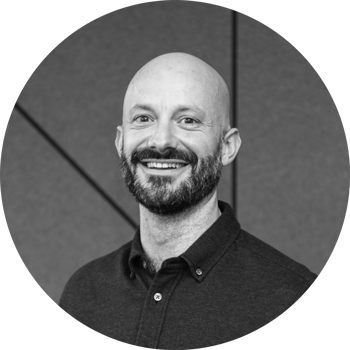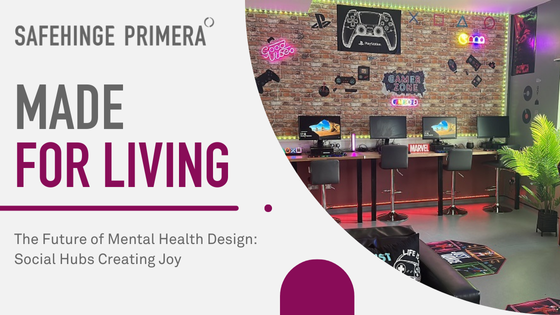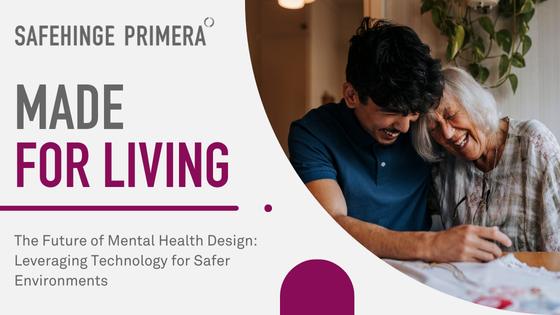When was the last time you truly experienced a space - not as a professional, but as a human?
Think about it. We walk into rooms, hospitals, offices every day, often seeing them through the lens of our roles - designer, clinician, architect. But what if we stripped all of that away and just felt a space? Would it be welcoming? Empowering? Or would it feel cold and clinical, designed more for containment than care?
.png?width=614&height=274&name=Email%20Header%201%20(13).png)
Francis Pitts, a leading voice in mental health architecture, has spent decades considering this very question. He believes the key to creating spaces that heal rather than just house people comes down to choice and agency - two fundamental human needs that he says are often overlooked in mental health design.
This shift in thinking challenges us to go beyond the basic standards of safety and compliance. Because real safety isn’t only about preventing harm - it’s about creating environments that support people in regaining control of their own lives.
Spaces that shape behaviour, not contain it
For too long, mental health facilities have prioritised safety above all else. Of course, it is crucial, but environments that focus solely on safety are stripped bare and can leave people feeling powerless.
Pitts recognised this early in his career while observing how young patients in forensic psychiatric units positioned themselves in a room. He noticed something interesting: those who felt vulnerable would naturally gravitate toward areas near staff, but not too close—just enough to feel safe without feeling watched.
That insight led to the idea of "places in between" - thoughtfully designed spaces where people can choose how much interaction or distance they want, rather than being forced into isolation or constant observation or being part of a large group.
The truth is, we all do this. We pick the seat in the café that faces the door. We stand near an exit at a crowded event. We make ourselves look busy on our phones when we’re waiting for a friend in a bar. These are the subconscious ways we manage our own safety, anxiety, and comfort. Yet, in mental health environments, people are often stripped of these choices.
So what if we designed mental health spaces with these natural behaviours in mind? What if, instead of sterile corridors and locked doors, we created environments where people felt safe because they had the ability to make choices about the level of social interaction, recognising this is not one or the other, but various shades of grey?

Sowenna CAMHS - photo credit Ryder Architecture
What’s merely important, and what’s absolutely essential?
Most mental health spaces today are built to meet regulatory safety requirements - but is that the best we can do?
Pitts argues that while compliance is important, it shouldn’t be the goal. Instead, we should design places that actually help people get better.
In Francis Pitt's recent podcast, Care on Air, the line that really stood out to me was ‘What’s merely important, compared to what’s absolutely essential’. Pitt asserts (and I agree!) that safety is important, but the part that is essential is helping someone on their recovery or stabilisation journey.
Take traditional inpatient units, for example. Many are built around long, double-loaded corridors, rows of bedrooms on either side of a stark hallway, prioritising sightlines from the nurses' station. It’s functional and efficient, yes, but it also feels institutional and isolating.
At Worcester Recovery Center, Ellenzweig (see below) Pitts and his team took a different approach. Instead of a single, endless hallway, they designed smaller, self-contained living areas, more like shared flats than hospital wards. This subtle shift changed the entire dynamic of the space. It allowed people to feel more in control of their surroundings, engage in smaller social groups, and transition more naturally back into the world outside.
Ultimately, mental health treatment should not just be about managing risk, but also about preparing people for life beyond the hospital walls.

Ellenzweig and architecture+, Associated Architects, Photo: Ellenzweig
Can every room be mentally healthy?
More and more, the conversation is shifting towards designing all spaces with mental health in mind, not just mental health hospitals.
After all, mental health crises don’t happen in just these spaces. They happen in A&E, in schools, in police stations, in workplaces. So why are most of these public realm spaces designed in ways that can escalate distress rather than reduce it?
Some hospitals are already starting to integrate mental health-friendly design into everyday medical spaces. For example, instead of having a single designated "mental health safe room," some facilities are making all patient rooms adaptable. That means softer furnishings, calming colours, and flexible layouts that can accommodate different needs—all without making it feel like a locked-down environment.
At its core, this shift is about recognising that mental health is not a separate issue—it’s part of the human experience, and our built environment should reflect that.
At the heart of this approach is a simple but radical idea: design for dignity.
Designing for dignity: The role of architecture in recovery
One of the most interesting things Pitts talks about is the connection between architecture and healing.
Earlier in his career, he spent time working on monastery designs, and he noticed something unexpected - many of the design principles that made monasteries feel peaceful and reflective can also be applied to mental health spaces.
The key was structured freedom. Monasteries provide quiet, private areas for solitude, but also communal spaces for connection, and enabling different scales of social groups. They allow people to engage with their surroundings on their own terms.
This same principle can be applied to mental health facilities. Instead of designing vast, impersonal lounge areas, expecting 20 people to all watch the same TV, we should be thinking about differing scales of group dynamics, creating spaces that feel more like homes and neighbourhoods than hospitals.
At Worcester, the team broke a 30-bed unit into three distinct ‘households’, they created ‘nooks’ for people to be visible and cocooned at the same time, seats at the end of a corridor space - comfortable for 2-3 people to gather. The result? A space that felt human, where people could socialise in groups that recognised where they were on their journey, establish routines, and regain a sense of normalcy.
The goal is to to keep people safe - and to help them heal. And healing happens in environments where people feel respected, trusted, and empowered.

Ellenzweig and architecture+, Associated Architects, Photo: Ellenzweig
Shifting the conversation around safety
Too often, safety in mental health spaces is seen in black and white: you’re either safe or you’re not. But real safety is more complex than that, especially when you consider the importance of enabling staff to manage and explore relational safety as part of the person’s care plan.
Pitts makes a powerful point: Out in the real world, we all use natural instincts to keep ourselves safe. We choose where to walk at night, who to sit near on the bus, when to leave an uncomfortable situation. But in mental health facilities, those decisions are often removed completely.
What if, instead of just creating barriers, we created options?
- Instead of constant observation, provide spaces where staff can be present without intruding on someone's space.
- Instead of locking doors, design rooms where people feel safe and secure without feeling trapped.
- Instead of rigid rules, create environments that allow for controlled choices and empower clinicians to do what they are best at.
By giving people even small moments of agency, we create a far greater sense of safety than any locked door ever could.
And when people feel safe because they have control - not because someone else has taken control away from them - that’s when true healing can begin.
The Future: Learning from the past, building for tomorrow
So where do we go from here?
The next wave of mental health design is about improving what we build, but should also focus on rethinking how we approach design entirely.
- That means moving beyond just “safe enough” and asking how we can create spaces that actually help people recover.
- That means recognising that mental health design goes beyond hospitals. It touches every space we interact with.
- That means putting dignity, autonomy, and human experience at the centre of everything we create.
Pitts summed it up best: "To not pay attention is a waste of time."
So, as you walk through your next project, step into your next design meeting, or evaluate the next mental health space, notice how it makes you feel.
- ask yourself:
"Am I just creating a space, or am I shaping a place where people can truly live?"
Because at the end of the day, good design is about people.
You can listen to the full 'Care on Air' podcast with Francis Pitts HERE
Join the Conversation
At Safehinge Primera, we’re passionate about creating environments that go beyond compliance to truly support recovery. How do you see choice and design intersecting in your work?
Let’s keep the conversation going. Together, we can shape the future of mental health spaces.
Get in touch with us to arrange a chat.






